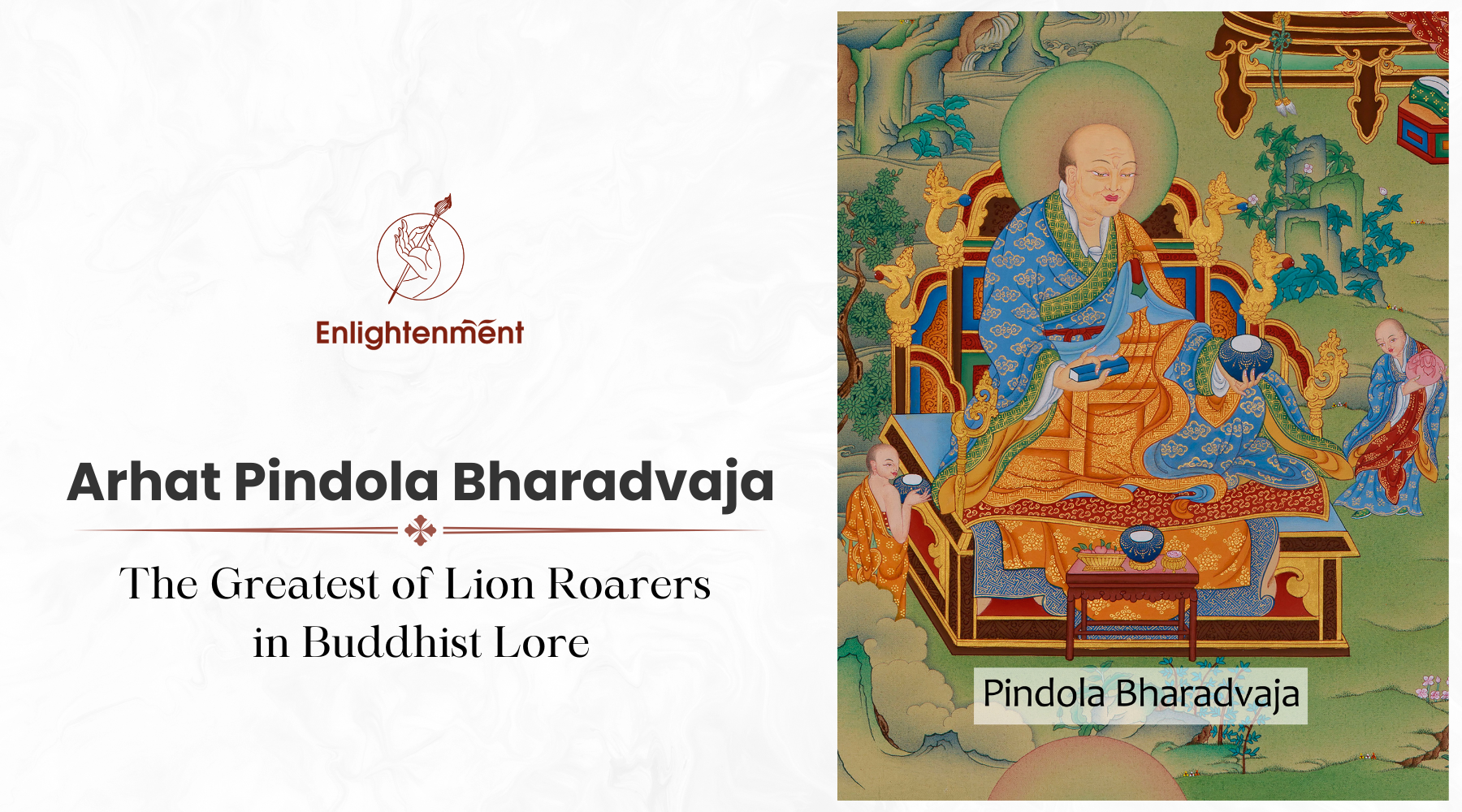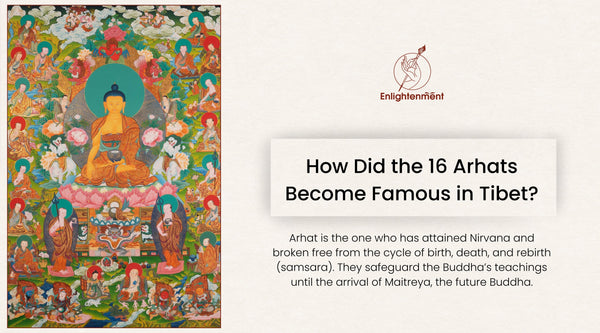Pindola Holds A Book And An Alms Bowl
Arhat Pindola Bharadvaja is an esteemed figure in Buddhist lore who is recognized for his profound wisdom and strong connection to the teachings of the Buddha. As one of the notable 16 Arhats, he is honored not only for his spiritual accomplishments but also for his guidance to others seeking enlightenment. In Buddhist art, he is often depicted with unique symbols like a book and an alms bowl, which are the result of the prayers he made to help the unfortunate beings who were unable to practice Sakyamuni Buddha's teachings. It is believed that when one sees or touches Pindola's book, they will be graced with wisdom and overcome shame. And his alms bowl has the power to grant all the wishes of those who see it. The fortunate beings will be granted "the seven riches of a Buddhist saint" and the happiness of both the gods and men.
In this detailed read, seek to illuminate Arhat Pindola Bharadvaja, his legendary stories, and his significance in Buddhist traditions, mainly into the significance of his impressive title, the Lion Roarer.
Who Is an Arhat in Vajrayana Buddhism?
The word “Arhat” (Sanskrit: अरिहत्, Arahant) often translates to “worthy one” or “one who is deserving of reverence.” They are also called Sthavira in Sanskrit, which translates to "Noble Ones." They are the ones who have attained Nirvana and broken free from the cycle of birth, death, and rebirth (samsara). They were the early disciples of the Shakyamuni Buddha who attained enlightenment. Despite achieving Nirvana, the sixteen Arhats have chosen to wait for the future Buddha, Maitreya, by safeguarding Tathagata's precious teachings.

Key Characteristics of an Arhat
-
Complete Liberation from Samsara: Arahats have completely eliminated all mental impurities, known as “kilesas” in Pali, which include greed, hatred, and ignorance.
-
Attainment of Nirvana: They have achieved a state of perfect peace, free from the burning fires of suffering.
-
Worthy of Offerings: They are often revered by laypeople and monastic communities alike, as making offerings to them is believed to generate substantial merit.
-
Inspiration for Others: Arahants act as proof of the Buddha’s teachings, exemplifying that liberation is achievable through diligent practice.
Explore the names of the Sixteen Arhats and their origin story.
The Noble Origin of Arhat Pindola Bharadvaja
Pindola Bharadvaja is traditionally listed as one of the “Sixteen Arhats” revered for a blend of wisdom, compassion, and mastery of supernatural abilities. He was among the earliest disciples of the Buddha alongside the future Arahants and other venerated figures like Sariputta and Maudgalyayana, the two chief disciples. His name, "Pindola," is believed to be a personal name, while Bharadvaja is his clan name. Bharadvaja is an ancient Brahminical gotra (clan) name, hinting that Pindola came from a Brahmin family. The Buddha had several disciples from Brahmin families, underscoring that the path to enlightenment is open to individuals from all backgrounds.
The legend of his early life suggests that Sthavira Pindola was born into a family of royal chaplains. His father ruled over a region due to their blue blood. Hence, the future Ariya grew up in a privileged household. It was later, when he grew up that he saw the gifts and respect given to the Buddha's disciples. While a young Bharadvaja realized that he was leading a meaningless life and entered monkhood, he was also driven by greed. He initially went out with a large begging bowl but he soon conquered his greed, an initiation by the Tathagata himself. With time, Pindola became one of the prominent disciples of the Bhagavan, and at times, the former even led his fellow ascetics with pure confidence.
Thus, it was the Buddha who referred to him as "the greatest of lion roarers" in the sense of Pindola's authoritativeness and his confidence.
Stories of Arhat Pindola Bharadvaja
Many rich details about Pindola Bharadvaja arise in local legends and apocryphal Tibetan texts. These narratives elaborate on his “lion’s roar” persona, describing him as able to quell disputes, teach with resounding clarity, and even manifest supernatural abilities to inspire faith in the Dharma. One legend goes like this:
One time, when the Sakyamuni went on his twenty-eight summer retreat, Pindola went to Kaushambi, an ancient city in India. There, he took up residence in a grove, and a large number of laymen visited him, hoping to get his blessings. He also bestowed them with the Buddha's teachings, and the number of converts grew quickly. One day, the respected king of the land happened to be in the forest to hunt, and he became curious to meet the Arhat, who was surrounded by a large flock of his subjects. The king, too, arrived at the holy grove but soon became displeased with the Arhat as the latter did not go out to welcome him, nor did Pindola rise from his seat when he visited.
The King was furious and made another visit but had resolved beforehand that if the ascetic failed to give him a respectful welcome, unlike before, then he would order to have the Arhat beheaded. And when the sage heard that the king was coming to his abode again, he wondered about the king's intention. Thus, to bring out a clear perception of the king's visit, Bharadvaja got up from his seat and soon realized the evil intention of the monarch. The sage then took six steps forward toward the king, and soon the ruler's royal and glamor vanished, and so did his physical radiance, but the interesting part was, the earth in front of the king tore apart. The King soon realized his fallacy, and he became filled with terror, but he confessed his evil intention, begging for Pindola's forgiveness.
The sage, being the kind being he was, forgave the king and also provided him a chance for atonement for his sin of disrespecting a holy sage. In the end, the Kaushambi King had to be away from his royal life, lost in an alien land where he was too far from receiving royal treatment, but came back being a calculated man. When the Kosanbi royal returned to his palace after fulfilling his predicament, he became a patron of the Buddha and his disciples when Tathagata visited him.
Iconography of Pindola Bharadvaja

Whether in grand murals of Tibetan monasteries, sacred thangkas, or lifelike statues, Arhat Pindola Bharadvaja is commonly depicted in vibrant artworks. Iconography often assigns him distinctive attributes, ensuring devotees can identify him among the array of Arhats.
- A Regal Pose: Many artists portray him seated in a dignified manner, suggesting his mastery and calm wisdom.
- Holding a Scripture and Alms Bowl: Symbolizing his role in teaching the Dharma, especially to the one from the lower forms of birth.
- An Expression of Serenity: He is shown with a serene and calm expression, symbolizing his deep inner peace and enlightenment.
- Monastic Attire: He is typically shown in the traditional robes of a monk, which symbolize his rejection of worldly desires and his dedication to the journey toward enlightenment.
- Shaved Head: Pindola, like all arhats, is typically depicted with a shaved head, representing his rejection of vanity and detachment from material appearances.
- Mountain Cave in the Back: This refers to him residing in a mountain cave in the East alongside 1,000 other Arhats.
The iconography of Arahant Bharadvaja is a potent reminder of the journey to enlightenment, highlighting the virtues of humility, wisdom, and compassion. His calm and wise presence in Buddhist art embodies the essential qualities of an enlightened being, inspiring practitioners as they seek spiritual liberation.
Pindola Bharadvaja’s Unique Association
Among the many disciples and Arhats, Pindola Bharadvaja stands out for his steadfast commitment to defending and spreading the Dharma, earning him the esteemed title of the Greatest of Lion Roarers. This reflects his dedication to the teachings of:
-
Eloquence: He can articulate profound truths in a way that resonates deeply with both laypeople and advanced practitioners.
-
Fervor for Protecting the Dharma: Whether facing skepticism or hostility, Pindola roars with unwavering clarity.
-
Representation of Longevity: He roars across the ages, implying that his teachings echo through time until the future advent of Maitreya Buddha.
Conclusion: Pindola Bharadvaja Is A Paragon of Arhat Idealism
Arhat Pindola Bharadvaja, the Greatest of Lion Roarers in Buddhist lore, stands as a timeless example of fearless clarity and steadfast devotion to the Dharma. From his humble background to overcoming greed and his tales of teaching Buddha's lessons, they all form the richly embroidered legends in Vajrayana traditions. He emerges as a beacon of unshakeable commitment. He represents the culmination of profound wisdom, compassion, and spiritual mastery.

His remarkable spiritual powers, like the ability to turn a small cave into a space that could hold 1,000 people, reflect his control over both the physical and mental realms. Yet, Pindola’s true greatness is found in his humility and dedication to serving others. Despite his incredible abilities, he chose a simple life, always prioritizing the well-being of others and the spread of the Buddha’s teachings. His life serves as an example for Buddhist practitioners, illustrating that spiritual achievement is not a solitary journey but one that contributes to the improvement of the world and the support of fellow beings. His presence gives rise to an unwavering faith in the Three Jewels (the Buddha, the Dharma, and the Sangha).
For modern practitioners, the life and legacy of Pindola Bharadvaja resonate through the ages, encouraging us to embody his virtues. Let us aim to speak the truth with bravery, protect the journey of awakening with determination, and always be aware of our duty to assist all beings. Through dedication, learning, and practice, we can also develop a lion’s roar—whether soft or strong—that echoes with compassion, wisdom, and limitless love for every living creature.
In this way, the story of Arhat Pindola Bharadvaja serves not as a relic from the past but as a vibrant reminder of the Buddha's essential message: liberation is within reach, the truth is deep yet within our grasp, and those who convey it do so with a powerful voice that resonates throughout all of existence. May his teachings illuminate our path toward enlightenment, encouraging us to become Lion Roarers ourselves—carrying the light of wisdom for both ourselves and all living beings.
Understand how the Sixteen Arhats became famous in Tibet on this link.


